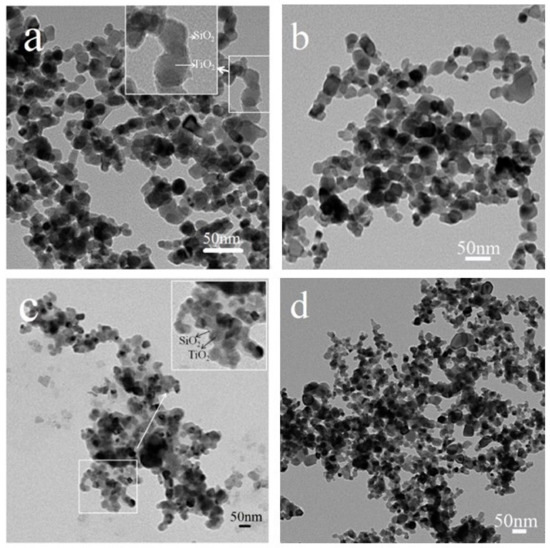

The incorporation of MNPs into a TiO 2 matrix can decrease the agglomeration of the nanoparticles, improve the durability of the catalyst, and increase their photocatalytic activity. In addition, MNPs are easily fabricated and have high separation efficiency, cost-effectiveness, and a simple operation process. Magnetic Fe 3O 4 nanoparticles (MNPs) have been of great interest because of their magnetic properties, high coercivity, and lack of toxicity. Recently, core- shell nanostructure composites have attracted increasing attention because of their various applications, such as catalysis, chromatography separation, drug delivery, and chemical reaction. Therefore, TiO 2-based semiconductors have been of great interest, and great efforts have been made to fabricate and design an ideal structure for TiO 2-based semiconductors to improve the efficiency of the TiO 2 nanoparticles. However, they also have disadvantages, such as the recombination of a generated redox environment, their absorption of a small amount of the UV light irradiation, a large band gap, and low selectivity. In recent years, photocatalysts have attracted many researchers, and the most frequently investigated photocatalysts are titanium dioxide (TiO 2) nanoparticles because they are chemically stable, can be regenerated, and are recyclable and non-toxic. Moreover, the magnetic separation properties of the core-shell Fe 3O 4/SiO 2/TiO 2 nanospheres can enable the prepared materials to have wider application prospects. The results show that the performance of the prepared core-shell nanospheres was better than that of commercial TiO 2 nanoparticles. The results revealed that the efficiency of the photocatalytic degradation of the core-shell nanospheres was not degreased after five runs that can be used as recyclable photocatalysts. It was found that 90.2% and 100% of binary MO and MB were removed for 5 h, respectively. The photocatalytic activities of the prepared core-shell nanospheres were studied using binary azo dyes, namely methyl orange (anionic dye, MO) and methylene blue (cationic dye, MB) in aqueous solution under UV light irradiation (365 nm), and UV-Vis spectrophotometer was utilised to monitor the amount of each dye in the mixture. The morphology and structure of the prepared materials were characterised by X-ray diffraction (XRD) analysis, scanning electron microscopy (SEM), X-ray energy dispersive spectrometry (EDAX), Fourier transform infrared spectroscopy (FT-IR), and atomic force microscopy (AFM). In this study, core-shell Fe 3O 4/SiO 2/ TiO 2 nanospheres with magnetic cores were obtained from synthesised magnetic Fe 3O 4 nanoparticles through the precipitation method, the surface of the magnetic Fe 3O 4 nanoparticles was coated with a silica (SiO 2) layer by hydrolysis of tetramethoxysilane (TMOS) as a silica source, and finally, Fe 3O 4/SiO 2 nanospheres were coated with titanium (TiO 2) layer using tetrabutyltitanate (TBT) as a precursor through the sol-gel process. Photodegradation has emerged as an environmentally friendly method of decomposing harmful dyes in wastewater.


 0 kommentar(er)
0 kommentar(er)
